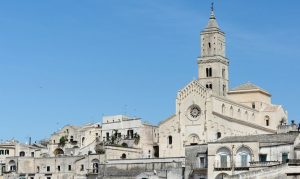Get lost in the timeless beauty of Matera, Italy’s best-kept secret!
Matera is a city in southern Italy. It is the capital of the Province of Matera and is in the region of Basilicata. Since the Paleolithic (10th millennium BC), people have lived there continuously. It is famous for its rocky urban core, which comprises two hillside zones called Sasi. The three-part city structure of Civita and Sassi, which were primarily separate from each other, lasted until the 16th century when the centre of public life moved outside the walls to the open plain (piano) in the Piazza Sedile. Sassi was named a UNESCO World Heritage Site in December 1993, along with the rupestrian churches on the road to Gravina. This has helped attract tourists and speed up the restoration of the site. Matera was the European Capital of Culture in 2019.
History of the city
Matera was ruled by the Romans, Lombards, Arabs, Byzantines, Swabians, Angevins, Aragonese, and Bourbons before it became part of the modern state of Italy. When did the first people move into the homes in Matera, or how long they stayed there after that? This may be one of the oldest places that have continuously been inhabited. Matera was founded in the year B.C. In 251, a Roman named Lucius Caecilius Metellus started it and called it Matheola. In the year 664 AD, the Lombards took over Matera.
Later, in the 7th and 8th centuries, Benedictine and Basilian monks moved into the nearby caves. When the Arabs took over Bari in 840, they also took over Matera. In April of 1064, the Count of Montescaglioso took control of the city and made it his own. After that, several different people were running the country, and in 968, the archbishop of Acerenza took back the bishopric of Matera. In May of 1082, a new cathedral for St. Eustace was blessed after a short time when people lived together and some plagues and earthquakes; the Aragonese took over the city in the 15th century.
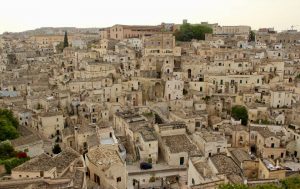
How To Get Into Matera
By air
You can fly into Bari-Karol Wojtyla Airport (BRI) or Brindisi-Salento Airport to get to Matera (BDS). Both are in the southern part of Italy. You can take a shuttle bus or a train from Bari-Karol Wojtyla Airport to Matera.
Several times a day, shuttle buses run. You can buy tickets at the airport or online. You can also train from Bari Central Station to Matera Central Station. It will take about an hour and cost between 5 and 10 euros. You can taxi from the airport or use the “AMTAB” public bus service to get to Bari Centrale station. You can take a shuttle bus from Brindisi-Salento Airport to the Lecce train station and then a train to the Matera Centrale train station. From Lecce to Matera by train takes about 2.5 to 3 hours and costs about €15 to €20. You can look at the schedule and buy tickets for the train online or at the station.
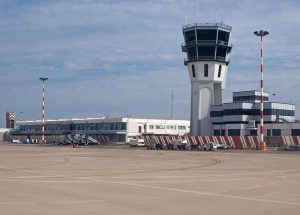
By rail
Matera is well connected by train to major cities in southern Italy. The town has its train station called “Matera Central,” which is on the line that goes from Bari to Matera. You can take a train from Bari to the Matara Central Station. It takes about an hour and costs between 5 and 10 euros. There are many trains every day, and you can check the schedules and buy tickets at the station or online.
If you are coming from another city in Italy, you can take a train to Bari Central Station and then switch to a train to Matera. It takes about an hour to get from Bari to Matera. You can also take a train to Taranto and switch to another train to get to Matera. It takes about 1.5 hours to get from Taranto to Matera. When you get to Matera Central Station, you can take a local bus or taxi to your hotel or walk around the city.
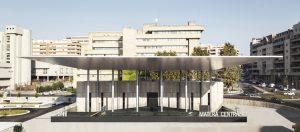
By bus
Matera is well connected by bus to the main cities of southern Italy. If you are coming from Bari, you can take a bus from Bari Bus Terminal or Bari Airport. The trip takes about 1.5-2 hours and costs about 5-10 euros. There are several buses per day, and you can check the timetables and book your tickets online or at the bus station. If you are coming from other cities in Italy, you can take a bus to Bari or Taranto and transfer to a bus to Matera.
Matera Climate
The weather in Matera is mild and warm. Matera is a city that gets a lot of rain. Even in the month with the slightest rain, it rains a lot. The Koppen-Geiger system says that the weather here is Cfa. The average temperature in Matera for the whole year is 15.4 °C. 593 mm of rain falls in a year. Matera is in the northern part of the world. Summer begins at the end of June and lasts until September. June, July, August, and September are summer months. June, July, and August are the best months to go.
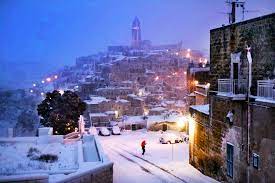

Top Sights In Matera
The Sassi di Matera
The Sassi di Matera is the oldest part of the city of Matera in southern Italy. People have lived there for thousands of years. It is a unique and inexcitinglace. The Sassi di Matera is built into the sides of limestone cliffs. It has narrow streets, old houses, and beautiful views.
The Sassi di Matera was left alone for a long time before a programme to fix them began in the 1980s. Today, Sassi di Matera is a popular tourist spot and a UNESCO World Heritage Site. People can walk around the narrow streets and lanes, visit the many rock churches, and look out over the city and the countryside in awe-inspiring ways. There are a lot of restaurants, cafes, and shops in the area where you can try local food and buy handmade items.
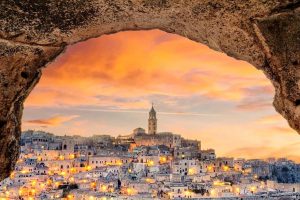
Rupestrian Churches
The Rupestrian Churches of Matera is a group of old Christian churches and monasteries carved into the soft limestone hills of Matera in the Basilicata region of southern Italy. In the caves and caverns of Matera, monks and hermits who wanted to be alone built these churches in the 8th and 9th centuries. People think that the rock-cut architecture of the Rupestrian churches is one of the world’s most essential and exciting things. It shows scenes from the Bible and stories about holy people. Matera’s most well-known Rupestrian churches are the Church of Santa Maria de Idris, San Pietro Barisano, and San Giovanni in Monterrone.
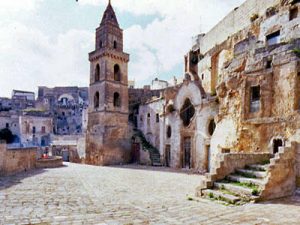
Cattedrale di Maria Santissima della Bruna
The Cattedrale di Maria Santissima della Bruna is the main cathedral in Matera. It is right in the middle of the old city centre. It is an excellent example of Romanesque architecture. The front is made of tuff stone, and the bell tower is 52 metres high. The cathedral stands on the site of an older church in the 13th century. It was made honouring the Virgin Mary and Matera’s patron saint, San Giovanni Battista. Over the years, it has been fixed up and added to. There are paintings and frescoes on the walls inside the cathedral. Cattedrale di Maria Santissima della Bruna is a must-see destination for anyone visiting Matera. It is one of the city’s most important landmarks because of its beautiful architecture, long history, and religious significance.
Palombaro
The Palombaro Lungo is a fascinating underground water cistern in the historical centre of Matera. It was built in the 1600s to collect rainwater and provide water to the city during droughts or sieges. The Palombaro Lungo is a marvel of engineering. It comprises underground chambers stretching over 1,500 metres and can hold up to five million litres of water. The cistern is held up by a network of columns and arches that look beautiful, and it has a system of channels and wells that let water flow in and out. Visitors can take guided tours of the Palombaro Lungo. These tours take people through the cistern’s underground maze and tell them interesting stories about the cistern and its role in Matera’s history.
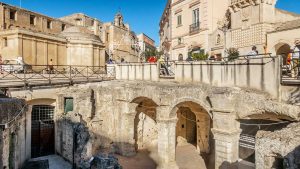
MUSMA Art Museum
MUSMA is a modern art museum in Matera, Italy. The museum opened in 2003 and is in the Palazzo Pomarici-Santomasi, a 16th-century palace in the city’s historic centre. MUSMA is a museum that is all about modern sculpture. It has pieces by local and international artists.
The museum has works by more than 70 artists, including Italian sculptors like Giuseppe Penone and Arnaldo Pomodoro and international artists like Richard Long and Antony Gormley. The collection has more than 100 pieces. The pieces in the collection are made of a wide range of materials and styles, from marble and bronze to glass and rubber.

Casa Grotta di Vico Solitario
The Casa Grotta di Vico Solitario museum is a cave house that has been fixed up. It shows visitors what life was like in ancient Matera. People lived there until the 1950s. Since then, it has become a museum.
The cave has several rooms, including a kitchen, bedroom, and living room. The original furniture and household items in the rooms give visitors a sense of what life was like for those living in the cave. Visitors can see the bed, the table, the fireplace, and other things from that time. The Casa Grotta di Vico Solitario is a unique and exciting museum showing how people live in Matera. Anyone interested in history, architecture, or anthropology should go there.
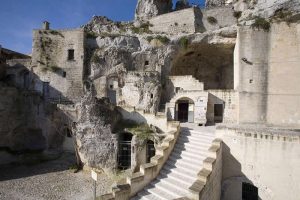
Crypt of the Original Sin
The Crypt of the Original Sin is an old rock church considered one of the area’s most important pieces of art and culture. It was built in the 8th or 9th century and is famous for its frescoes covering almost all its walls. The frescoes in the crypt show scenes from the Bible, like when God made Adam and Eve when the first sin happened and when God kicked Adam and Eve out of the Garden of Eden. These frescoes are painted on a dark background, so it makes them stand out.
After being buried for a long time, the Crypt of the Original Sin was found again in 1963. It is now open to the public, but because it is fragile, only a certain number of people can be there simultaneously. The crypt is also a UNESCO World Heritage Site.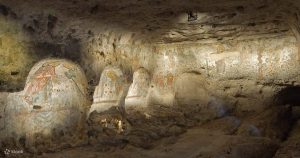
Matera City Details
Matera is on the south side of the Gravina River. The canyon of the Gravina River separates the Basilicata Mountains (historical Lucania) to the southwest and the Murgia Plateau of Apulia to the northeast. At first, the city was made up of a group of caves dug out of the soft limestone on the western, Lucanian side of the Flood.
Matera currency: Euro
Weather: 7°C, Wind E at 11 km/h, 76% Humidity
Population: 60,351 (2017)
Matera official language: Italian
Matera (Italy) dials Code: +39
Getting around in Matera
The historical centre of Matera is only accessible on foot, so walking is one of the best ways to see the city. Walking through the city’s small streets and alleys, you can fully appreciate its unique architecture and cultural history. Matera’s bus system links different parts of the city and nearby towns and villages. The central bus station is in the city’s historic centre at Piazza Matteotti. You can buy a ticket at the bus stop or the train station. Taxis are easy to find in Matera, and you can call one from the street or book one beforehand. They can be more expensive than other ways to get around, though.
You can rent bicycles in Matera, and bike lanes in the city make getting around on a bicycle easier. On the other hand, the historical centre of Matera has many steep stairs and narrow streets that can make cycling difficult. Matera is not a good place to drive a car, and there are many places in the historical centre where cars are prohibited. If you decide to go, parking outside the city centre and walking in is best. Walking is the best way to get around Matera because it lets you fully appreciate the city’s unique architecture and cultural history.
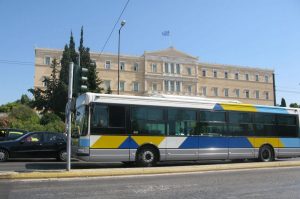

Matera Cuisine
Matera’s food resembles southern Italy’s “cucina povera” (poor nutrition). It has a mix of Basilicata and Apulia food because it borders the two regions. “Peperoni cruschi” and “Pane di Matera” are two of the highlights. “Pepperoni crushing” is a sweet and dry pepper from Basilicata famous for its intense flavour and conical shape and has been given Protected Geographical Indication (PGI) status. The city produces appellation wines bearing the Denominazione di origine controllata (DOC) designation.

Matera Nightlife
Matera is One popular activity is to take a guided night tour of the Sassi, which offers a unique perspective on the city’s history and architecture. Many churches and other Sassi buildings are beautifully lit at night, creating a magical atmosphere.
There are also several bars and restaurants in Matera where you can enjoy a drink or a meal. Piazza San Pietro Caveoso and Piazza Vittorio Veneto are popular spots for a night out, with various bars and restaurants. If you’re looking for live music, check out the Casa Cava, a cultural centre housed in a former cave that hosts concerts and other events. The nearby city of Bari also has a lively music scene, with many clubs and venues featuring local and international artists.
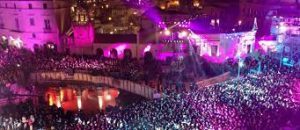
Approximate Budget
It would be best if you planned to spend about €133 ($145) per day on your trip to Italy. This is the average daily cost based on what other tourists have spent. On average, travellers have spent €36 ($39) on food for one day and €21 ($23) on getting around town. Also, the average hotel room cost for two people in Italy is €135 ($147). So, two people going to Italy for a week will spend an average of €1,863 ($2,025).
Conclusion
Matera is a must-see. It is known as the “City of Stones” and the “City of Caves.” When you first see the city from one of the many lookouts, it will feel like you’ve returned in time. In fact, after Aleppo and Jericho, this is the third oldest city that has always had people living there. On the side of a rocky valley, cave homes, zigzag staircases, and ancient churches with unique frescoes dominate the landscape.
Check out other cities in Italy:

